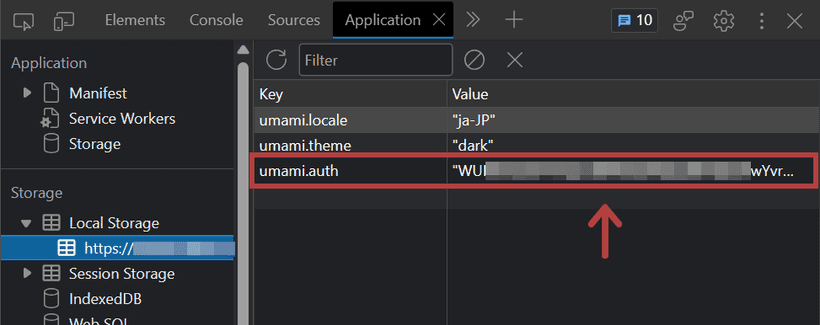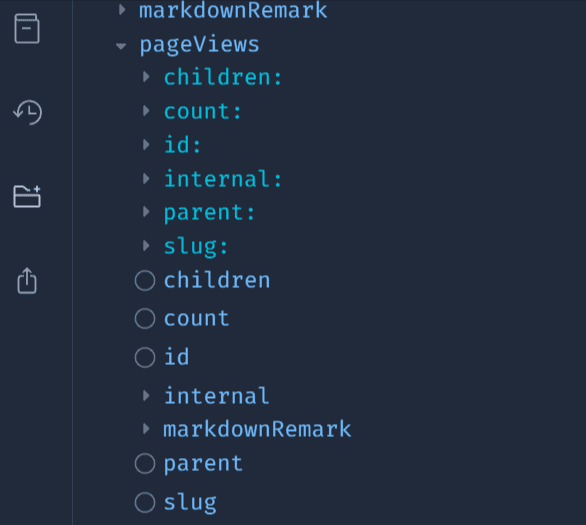How to Create a Popular Posts Ranking with Umami Analytics + Gatsby
Umami Analytics is a privacy-first, open source analytics. We can host it by ourselves besides its freemium cloud version with limited features.
Last time, I wrote how to run Umami Analytics + Supabase + Vercel for free.
This time I'd like to show you how to get the popular posts from Umami API and how to output this data to Gatsby's GraphQL.
I have tested my codes with a self-hosted Umami. I didn't test with Umami Cloud.
Environment
- Umami v2.2.0
Prerequisite
- Umami is already being running (see how to run Umami Analytics for free)
Getting a Token
First you need to get a token to connect to the Umami API.
We can get the token by the official way, but the easiest way is;
Go to your Umami page and check the umami.auth value from F12 -> Application -> Local Storage.

Link - Authentication | Umami
Checking out the Website ID
Besides the way shown by Umami official, the easiest way is;
Go to your Umami page, view the details of your website, and check the URL.

Link - Websites | Umami
Connecting to the API
Once you have the token and the Website ID, you can use JavaScript fetch to the metrics data.
const today = new Date()
const todayTs = today.getTime() // Curent timestamp
const sevenDaysAgoTs = todayTs - 604800000 // Timestamp of 7 days ago from now
const params = { startAt: sevenDaysAgoTs, endAt: todayTs, type: "url" }
const query = new URLSearchParams(params)
const response = await fetch(
`https://my-umami.example.com/api/websites/[UMAMI_WEBSITE_ID]/metrics?${query}`,
{
method: "GET",
headers: {
Accept: "application/json",
Authorization: `Bearer [UMAMI_AUTH]`,
},
}
)
const data = await response.json()
console.log(data)Link - Website statistics
What we can get here with the code is the paths and the number of visitors. It means it contains the home page or the contact page.
[
{x: "/", y: 46}
{x: "/post/my-first-post/", y: 17}
{x: "/post/my-second-post/", y: 14}
{x: "/about/", y: 12}
]If you only want the blog pages, filter the json data with the conditions like "including /post/ value in x" when extending it with forEach or map.
Also, for security reasons, the token and Website ID should be managed in .env files.
UMAMI_AUTH=123456789012345678901234
UMAMI_WEBSITE_ID=abc-def-ghi-jkl-mno-pqrWhat next after getting json data?
To show the popular posts on your website, get the most 5 viewed paths and show the titles and the links regarding to the paths.
With Gatsby.js
I am good at Gatsby, so I create a schema of popular articles in gatsby-node.js; link the paths (obtained from the Umami API) to the article slugs, so that we can retrieve article data from the popular articles schema in GraphQL.
*Example of a Gatsby site managing articles in Markdown
const fetch = require("node-fetch")
// Generating PageViews schema
exports.sourceNodes = async ({
actions,
createContentDigest,
createNodeId,
}) => {
const { createNode } = actions
const today = new Date()
const todayTs = today.getTime()
const sevenDaysAgoTs = todayTs - 604800000
const params = { startAt: sevenDaysAgoTs, endAt: todayTs, type: "url" }
const query = new URLSearchParams(params)
const response = await fetch(
`https://my-umami.example.com/api/websites/${process.env.UMAMI_WEBSITE_ID}/metrics?${query}`,
{
method: "GET",
headers: {
Accept: "application/json",
Authorization: `Bearer ${process.env.UMAMI_AUTH}`,
},
}
)
const data = await response.json()
data.forEach(node => {
node.x.includes("/post/") &&
createNode({
slug: node.x.split("/")[2], // slug
count: node.y, // pageview number
id: createNodeId(`${node.x}`),
internal: {
type: "PageViews",
contentDigest: createContentDigest(node),
},
})
})
}
// Linking Markdown data to the PageViews schema
exports.createResolvers = ({ createResolvers }) => {
const resolvers = {
PageViews: {
markdownRemark: {
type: "MarkdownRemark",
resolve(source, args, context, info) {
return context.nodeModel.findOne({
query: {
filter: {
fileAbsolutePath: { glob: `**/**/${source.slug}.md` },
},
},
type: "MarkdownRemark",
})
},
},
},
}
createResolvers(resolvers)
}By doing this, the PageViews schema is generated and also has a corresponding Markdown data connected by the same slug.

With GraphQL's sorting or limiting, you can get "the most 5 viewed posts" so easily.
(This flexibility of GraphQL is one of the reasons I love Gatsby.js!)